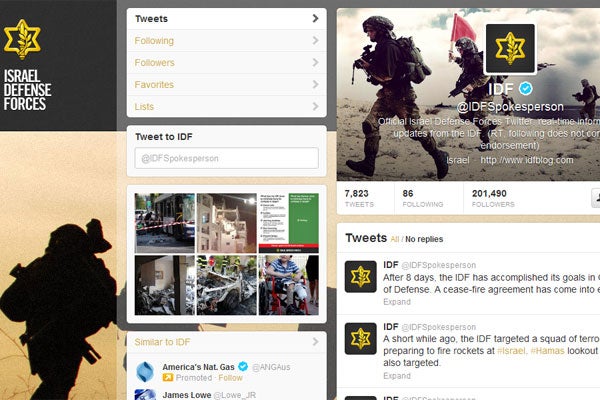Twitter, blogs, and YouTube accompanied rockets, bombs, and aircraft as weapons in the conflict between Israel and Hamas that concluded in a ceasefire last week.
The Israel Defense Forces (IDF) had taken to the blogosphere in order to update the world about the number of rockets that have hit Israel since Hamas started launching them earlier this month. IDF blog posts such as “How Long Has Hamas Been Shooting Rockets at Israel” aimed to add context to the conflict.
As Israel began responding to Hamas’s aggression with an airstrike campaign, the IDF also deployed social media weapons to aid its cause. It posted a YouTube video of a precision air strike that killed Ahmed Al-Jaabari, the leader of the Izz ad-Din al-Qassam Brigades, Hamas’s militia. After the attack, IDF tweeted:
We recommend that no Hamas operatives, whether low level or senior leaders, show their faces above ground in the days ahead.
— IDF (@IDFSpokesperson) November 14, 2012
The message was retweeted more than 4,800 times.
The IDF, however, did not monopolize social media throughout the conflict. The al-Qassam Brigades responded to Israel’s warning by tweeting:
@idfspokesperson Our blessed hands will reach your leaders and soldiers wherever they are (You Opened Hell Gates on Yourselves)
— Alqassam Brigades (@AlqassamBrigade) November 14, 2012
At first glance, it might appear that social media played only a superficial role in the Israel–Hamas conflict. However, in a world where social media represents an increasingly important medium for keeping people informed about current events, websites such as Twitter and YouTube are valuable tools in trying to shape public opinion.
According to a Pew Research Center study, in 2012, 36 percent of Americans reported seeing news on social networking sites within a day of being surveyed, compared to 19 percent in 2010. Add in the fact that TV and print news consumption continues to decline, and it isn’t hard to understand why the IDF and Hamas are waging war on this second battleground.
The U.S. should also learn to fight in this new media environment if it is going to combat the homeland security threats it faces. Al-Qaeda has already shown that it can adeptly use social media to frame its cause as right and just. Ayman al-Zawahiri, the current head of al-Qaeda, once said that “we are in a media battle for hearts and minds.”
The ability to use the Internet as a propaganda tool is what made al-Qaeda operative Anwar al-Awlaki so dangerous. His message inspired Umar Farouk Abdulmutallab (the underwear bomber) to attempt blowing up a plane and Major Nidal Malik Hasan to kill U.S. soldiers at Fort Hood.
The growing prominence of social media in informing the public has created a new battleground. Governments that fail to heed to this knowledge do so at their own peril.
Steven Ballew is currently a member of the Young Leaders Program at The Heritage Foundation. For more information on interning at Heritage, please visit: http://www.heritage.org/about/departments/ylp.cfm.
